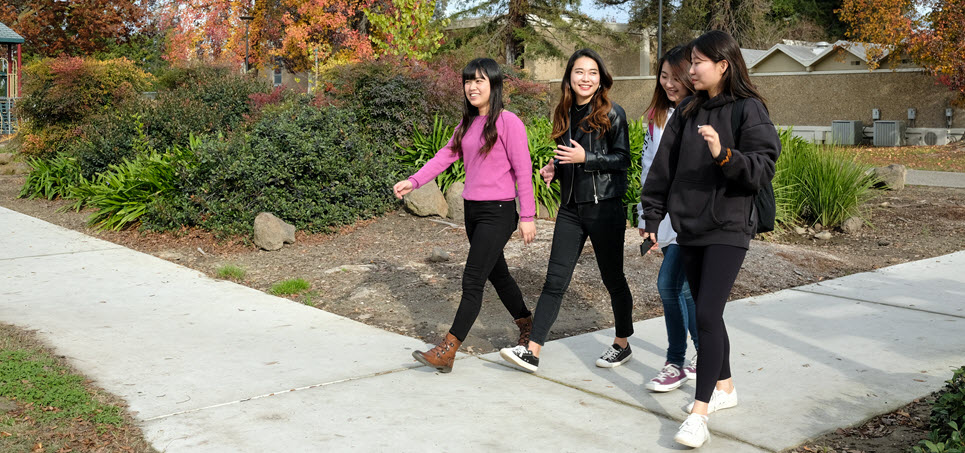
In countries with a large Christian population, Christmas is a highly-anticipated celebration. Thamieska Mendes explains that Christmas in her native Brazil is very similar to Christmas in the United States. Families gather and exchange gifts and children eagerly await Santa Claus, whom they call “Papai Noel.”
“But we don’t have real Christmas trees,” Mendes said. In São Paulo, where Mendes is from, giant Christmas trees made of electric lights can be seen throughout the city. In Mendes’ home, she celebrates with a fake pine tree. The real ones are much harder to find in Brazil.
For other international students at Stan State, Christmas is either seen as a fun day to go out shopping or is not celebrated at all. But that doesn’t mean they don’t celebrate the holidays. Instead, the New Year is a significant holiday in their culture.
Japanese students Sawa Imazu, Akari Otobe and Mayu Suzuki like to watch a national New Year’s Eve TV special with their families, usually under a “kotatsu,” a low table frame covered by a blanket which is beneath a table top. Beneath the table sits a heater, keeping the family warm during the freezing winter.
“We like to eat mandarin oranges while we sit at the kotatsu and watch TV together,” said Imazu.
Otobe likes to eat mochi soup for breakfast on New Year’s Day. Mochi are Japanese rice cakes. Imazu likes to eat Toshikoshi Soba noodles.
“Toshikoshi means ‘jumping into the New Year,’” explained Imazu.
There are also special bento boxes, which are lunch boxes, and each individual food has its own meaning. For example, eating shrimp represents a long life because it molts its skin.
Otobe, who was raised in the U.S., remembers participating in these traditions with her mom.
“We would visit the shrine and pray for the new year,” Otobe said.
When approaching a Shinto shrine, Imazu bows twice, claps twice, bows once, throws money into the offering box, prays and then buys charms that provide divine protection. She also picks out a paper from a box without looking, and on the paper is written what kind of luck one will have in the new year. The fortunes called “Omikuji,” can be bad or good.
Sewon Kang, a student from Seoul, South Korea, looks forward to watching the bell-ringing ceremony on TV, which is similar to how Americans watch the Times Square ball-drop once the clock strikes midnight on New Year’s Eve.
She enjoys eating sliced rice cake soup, or “tteokguk,” and she enjoys spending the new year with friends and family.
“Many South Koreans go to the sea or to the mountains to see the sun rise for the new year,” Kang said. But because it is usually snowing where she lives, she prefers to stay inside.
Xinwei Li and Ruijie Juang (who goes by Richard at Stan State) are both from China, but because Juang is from Shanghai and Li is from northern China, their traditions differ slightly. Peichuan Tsai (who also goes by Jen) finds many similar traditions with both Li and Juang even though she is from Taiwan.
Li explains that China goes by the Lunar Calendar, so the new year will be celebrated on Jan. 25 in 2020. Technically, celebrations begin the day before, she said, and like Americans they stay up until midnight to be awake for the new year.
Tsai explained that if children stay awake throughout the night, their parents will live long lives.
Juang said his family also drinks half a cup of sweet tea on New Year’s Day. “This means your new year will be sweet and warm,” explained Tsai.
Tsai, Li and Juang all enjoy the tradition of receiving small red envelopes filled with money. Red symbolizes good luck, and the symbols on the envelopes are meant to ward off evil spirits.
The first five days of the new year are the most important, they explain, so this time is spent with family members. This is when elders give red envelopes to those in the next generation who are unmarried.
Tsai, Li and Juang said they all keep leftovers from New Year’s Eve and include them in their meal on New Year’s Day for good fortune. They also keep a fish on the table for several days. For Juang, it’s four days, and for Tsai, it’s five.
Whether they celebrate with fish, money or sticky candy, what these students share as the semester ends and the holiday season emerges is a strong desire to look forward to what lies ahead — in their Stan State student careers and beyond.